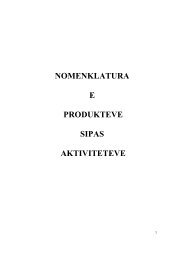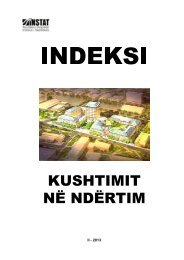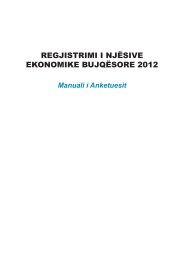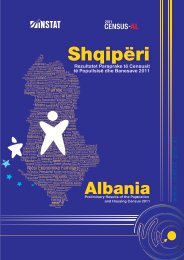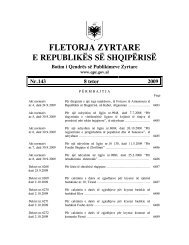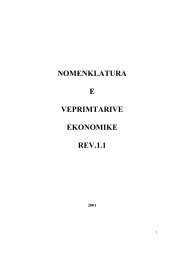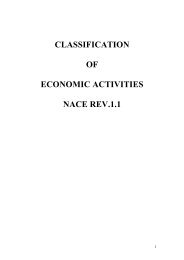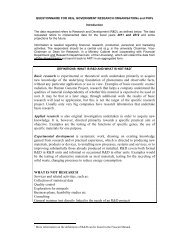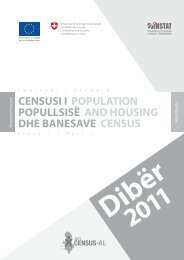Description of methods and sources for Albania - INSTAT
Description of methods and sources for Albania - INSTAT
Description of methods and sources for Albania - INSTAT
- No tags were found...
Create successful ePaper yourself
Turn your PDF publications into a flip-book with our unique Google optimized e-Paper software.
IPA 2009 Multi-beneficiary StatisticalCooperation Programme2.6 Farm structure surveyTo obtain the agriculture statistical in<strong>for</strong>mation in terms <strong>of</strong> market economy, it isnecessary to use the contemporary statistical <strong>methods</strong> <strong>of</strong> data collection. For thispurpose, in collaboration with the US experts <strong>of</strong> NASS (National AgriculturalStatistical Service) <strong>and</strong> Agricultural Department, collection <strong>of</strong> data through SamplingSurvey using Area Sampling Survey (ASF) method was considered as moreappropriate.This methodology used since 1994, started with 400 segments <strong>and</strong> then with 600segments.MethodologyThe Area Frame sampling selection method is one type <strong>of</strong> multi-stage clustersampling.To per<strong>for</strong>m a statistical survey on <strong>Albania</strong>n Agriculture it was necessary to use thismethod because an up-to-date list frame with the names <strong>of</strong> all <strong>Albania</strong>n farmers wasnot available <strong>and</strong> also it was difficult to compile one since rural population wasmoving toward the cities <strong>and</strong> the list would need to be frequently updated. There<strong>for</strong>e,with the Annual Agricultural survey, segments were sampled, farmers in each onewere listed, <strong>and</strong> farmers were sampled from each list <strong>and</strong> interviewed.Steps followed in designing the frameStratification: Agriculture <strong>and</strong> livestock activities differ between regions <strong>of</strong> thecountry. To improve the data collected on new activities the l<strong>and</strong> was first split intohomogeneous zones (strata) prior to sample selection. The stratification method usedincluded:1.Allocating l<strong>and</strong> in strata (homogeneous zones) based on defined criteria (in ourcase, l<strong>and</strong> use intensity):2.Further allocating the strata into groups <strong>and</strong> then sub-groups which weresimilarly based on the defined criteria.Multi-stage sampling: Each stratum was first split into Primary Sampling Units(PSU-s). Once the PSU had been defined <strong>and</strong> measured by using GIS, they were thensplit into segments based on target sizes desired in each stratum. Sample PSU-s wasthen selected on the basis <strong>of</strong> the number <strong>of</strong> segments located in each one. The use <strong>of</strong>this technique significantly reduced the required mapping measurement ef<strong>for</strong>ts.Analyses: The decisions on design were made on the basis <strong>of</strong> criteria <strong>of</strong> datareliability as well as the costs. This included the decisions made on defining thestrata, the number <strong>of</strong> sub-strata, size <strong>of</strong> segments, the method <strong>of</strong> sample selection,etc.191/236



